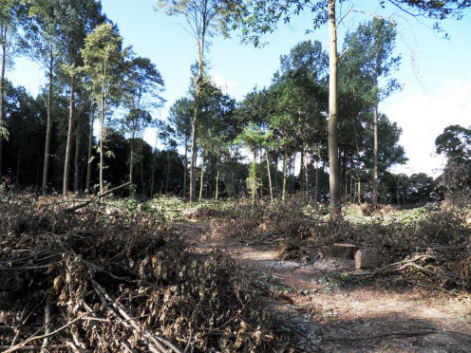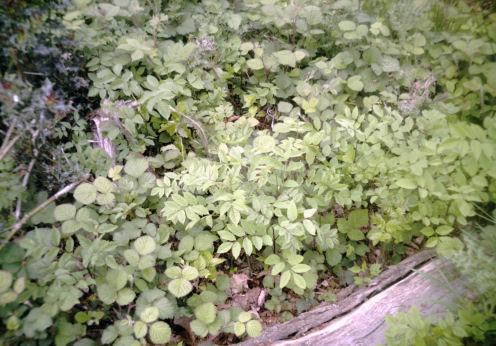|
Woodland operations, regeneration and impactWoodland work varies depending on how compartments are structured. Timing, space, light and regeneration also determine the shape of operations and how extensive work will be. Depending on the silivcultural system, work might involve any of the following: *Cutting larger diameter coppice eg sweet chestnut or firewood on a long cycle *Cutting smaller diameter coppice eg hazel on a short cycle *Timely or delayed thinning *Selecting individual trees or groups of trees under a gap regeneration or continuous cover system *Clear felling which may or may not be phased over a few years
Work generally involves a felling gang or harvester, and extraction of timber by forwarder.
In many circumstances, forestry operations can have a great physical and visual impact, depending on how extensive the work is. Over larger felling areas, the site can look a “mess” initially. But a mess in natural systems is opportunity for regeneration if stools are protected, and if sufficient parent trees remain to seed into the variation of microsites which result. Germinating seedlings will establish rapidly with the help of an existing and undamaged mycorrhizal network. Variation in seedling ecology is further enhanced by sensible brash management during operations. Where fencing may not be necessary, brash will also protect against low level deer browsing. Alternatively electric fencing or other forms of protection may be necessary.
The aim is to have a new generation of trees establishing. Species variation may be enhanced or ultimately changed by planting at low densities amongst the matrix. It is worth spending a bit of time and money on this enrichment planting, to ensure the sapling gets the very best start. Strategic positioning of plants between stools is important, as is a forking of the soil to decompact in the planting zone. Planting and plastic mulch It might sound elaborate and expensive to be mulching in restock sites, but 1 meter plastic mulch mats help in rapid establishment. Plastic mats are particularly good compared to other mulches because they: * Eliminate competing weeds and grasses * Retain moisture under the mat, very important in increasingly dry seasons * Warm the soil under the mat, which speeds up mineralisation of nutrients and stimulates root growth early in the season. This cannot be said for organic mulch, which has an insulating effect * Can nearly double initial growth compared to other forms of weed control * Avoid the use of chemicals * Are simple to put down, and can be reused after a couple of years
Succession Over time, dormant bramble may develop, replacing the decaying brash as protection for established saplings. Good sites will see tremendous emergence of vegetation in the first five years. Rapid growth of some species will be at the expense of others as natural succession begins in the first wave, and canopy closes. Slower growing species may need to be given a helping hand to avoid being overtopped, though side shading encourages the development of good form in trees. The whole site is absorbing carbon in the bodies of new trees and shrubs, replacing the carbon taken from the previous extracted crop. Compaction Especially in wet conditions and on heavy land, tractor and machinery movement compact the soil, affecting its structure, and reducing movement of moisture, gasses and minerals. It also creates a physical pan which makes it difficult for the roots to penetrate, and for the movement of other beneficial soil fauna. On light soils the impact is reduced, to the rare or possibly academic point where pure sand will be unaffected by heavy machinery. Compaction in clays and loams is not permanent though. Summer drought and evapo-transpiration deeply crack clay soils and break the pan. Re wetting in subsequent winters swells it again, and over a long time, the repeated process restores original condition. Unless the season is exceptional though, it is always preferable to restrict movement of machinery to dry conditions, and the use of brash as a mat where possible reduces compaction and damage to soil structure. |

